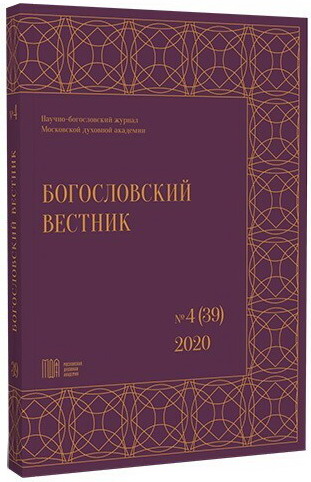«Your Fathers, Where are They? » (Zech. 1, 5): On the Question of the Genealogy of the Prophet Zechariah
DOI:
https://doi.org/10.31802/GB.2021.40.1.001Keywords:
the book of Zechariah, the book of Ezra–Nehemiah, books of biblical prophets, genealogy, patronymic, the Old Testament Priesthood, the Second Temple, «cultic prophet», post-exilic Judean community, structure of Judean societyAbstract
One of the exegetical problems of the book of the prophet Zechariah is the mentioning him as «the son of Berechiah, the son of Iddo» in Zech. 1.1.7. A number of scholars believe that in this verse this prophetic book contradicts the information of the book of Ezra–Nehemiah. At the same time, the solution to the question of the genealogy of the prophet Zechariah will make it possible to find out his origin and social status in the post-exilic Jewish community. This article discusses the issue of the genealogy of the prophet and his relationship to the post-exilic priesthood. Considering the problem in the context of other prophetic books of the Old Testament, the author makes an attempt to connect the mentions of Berechiah and Iddo with the theme of «fathers» — previous generations of Jews.
Downloads
References
Источники
Вiblia Hebraica Stuttgartensia / ed. R. Kittel. Stuttgart: Deutsche Bibelgesellschaft, 51997.
Septuaginta, Id est VetusTestamentumgraece iuxta LXX interpretes / ed. A. Rahlfs. Stuttgart: Deutsche Bibelgesellschaft, 1979.
Cyrillus Alexandrinus. Commentariorum in XII prophetas minores. In Zachariam prophetam // PG. T. 72. Col. 9–275.
The Bible in Aramaic Based on the old Manuscripts and Printed Texts. Vol. III: The Latter Prophets According to Targum Jonathan / ed. by A. Sperber; 2 impression. Leiden; New York; Köln: E. J. Brill, 1992.
Theodoretus Cyrensis. Interpretatio Zachariae prophetae // PG. T. 81. Col. 1873–1959.
Литература
Арсений (Соколов), иг. Книга пророка Амоса. М.: Новоспасский монастырь, 2012.
Глаголев А. А., свящ. Закон ужичества, или Левиратный брак у древних евреев. Киев: «Пётр Барский в Киеве», 1914.
Дандамаев М. А. Вавилония в 626–330 годы до н. э.: социальная структура и этнические отношения. СПб.: Петербургское лингвистическое общество, 2010.
Дандамаев М. А. Культура и экономика древнего Ирана / ред. В. Г. Луконин. М.: Главная редакция восточной литературы издательства «Наука», 1980.
Лебедев П. Ю. и др. Иоиль // ПЭ. 2011. Т. 25. С. 356–367.
Лосский В. Н. Предание и предания // ЖМП. 1970. № 4. С. 61–76.
Неклюдов К. В. и др. Исаия // ПЭ. 2011. Т. 27. С. 104–112.
Рождественский Д., свящ. Книга пророка Захарии: исагогическое исследование. Выпуск I: Введение. Писатель и его время. Анализ содержания книги. Сергиев Посад: СТСЛ, 1910.
Солярский П. Ф., прот. Опыт библейского словаря собственных имён: в 5 т. Т. 2. СПб.: Тип. Ф. Г. Елконского, 1881.
Фрэзер Д. Д. Фольклор в Ветхом Завете. М.: Политиздат, 1985.
Шаблевский Н. Н. Левиратный брак // ПЭ. 2015. Т. 40. С. 617–619.
Alonso Schökel L., SicreDiaz J. L. Profetas. T. 2. Madrid: Ediciones Cristiandad, 1980.
Barthtelemy, D. Critique textuelle de l’Ancien Testament T. 3: Ezechiel, Daniel et les 12 Prophetes. Fribourg Suisse: Editions Universitaires; Göttingen: Vandenhoeck und Ruprecht, 1992.
Cook St. L. Prophecy and Apocalyptism. Minneapolis: Fortress Press, 1995.
Edelman D. V. The Origins of the Second Temple: Persian Imperial Policy and the Rebuilding of Jerusalem. New York: Routledge, 2014.
Halpern B. The Ritual Background of Zechariah’s Temple Song // The Catholic Biblical Quartely. 1977. Vol. 40. № 2. P. 167–190.
Leggett D. A. The Levirate and Goel Institutions in the OT: With Special Attention to the Book of Ruth. Cherry Hill (NJ), 1974.
MacKay C. Zechariah in Relationship to Ezekiel 40–48 // The Evangelical Quarterly. 1968. № 40. P. 197–210.
Mitchell H. G. et al. A Critical and Exegetical Commentary on Haggai, Zechariah, Malachi and Jonah. Edinburgh: T. and T. Clark, 1912.
Petersen D. L. Zechariah’s Visions: A Theological Perspective // Vetus Testamentum. Vol. 34. Fasc.2 (Apr. 1984). P. 195–206.
Pola T. Das Priestertum bei Sacharja. Tübingen: Mohr Siebeck, 2002. (Forschungen zum Alten Testament; Bd. 35).
Sellin E. Studien zur Entstehungsgeschichte der jüdischen Gemeinde nach dem babylonischen Exil. Studie II: Die Restauration der jüdischen Gemeinde in Jahren 538–516. Das Schicksal Serubbabels. Leipzig: Deichert’sche Verlagsbuchhandlung nachf. (Georg Böhme), 1901.
Seybold Kl. Bilder zum Tempelbau: Die Visionen des Propheten Sacharja. Stuttgart: KBW Verlag, 1974.
Tollington J. A. Tradition and Innovation in Haggai and Zechariah 1–8. Sheffield: A and C Black, 1993.








